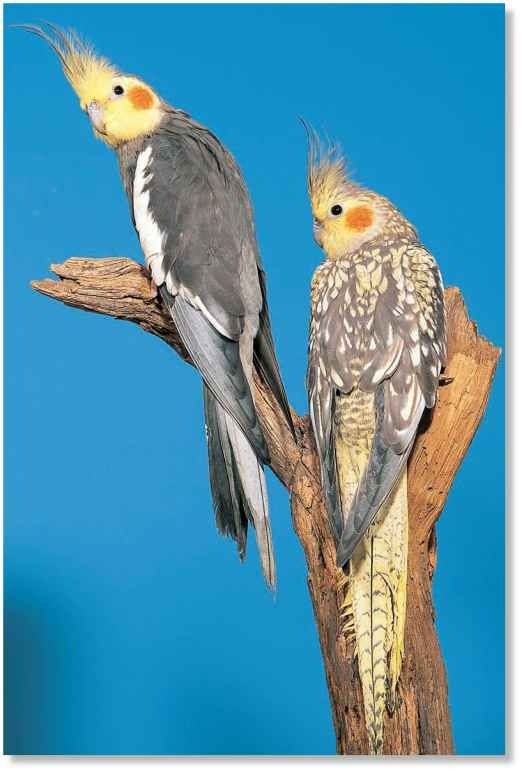ORDER
Psittaciformes
FAMILY
Cacatuidae
GENUS & SPECIES
key features
• The cockatiel is the smallest cockatoo, weighing only 3.5 oz.
• Searches for seeds, fruits and berries on or near the ground
• Devoted mate and parent; remains paired year-round and both sexes care for young
• Keeps its distance while perching, but is usually gregarious, traveling in flocks of several hundred
where in the world?
Found exclusively in and throughout Australia; especially numerous in the northern regions and rarely found along the continent’s many coastal areas
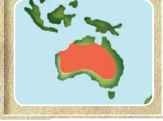
Lifecycle
Extremely faithful, the cockatiel is noted for its touching concern for an injured comrade; if one member of a flock is hurt, the others will hover about the bird to protect it.
HABITAT
Cockatiels prefer open, lightly timbered country close to a source of freshwater; such as open woodlands and savannahs, threaded with waterways or bordered by water holes. Flocks also live in more arid parts of Australia, foraging for food in one place and flying some distance for water. Cockatiels prefer large, dead eucalyptus trees, on which they perch on the stout outermost branches. Cockatiels are able to endure extreme temperatures as low as 42°F and as high as 1 I0°F. This ability to endure extreme temperatures enables the cockatiel to inhabit areas where other cockatoos or parrots usually cannot survive.
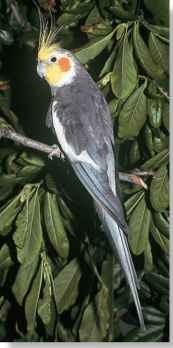
A Private perch Cockatiels prefer trees near steady water supplies.
BEHAVIOR
Cockatiels can be found in pairs and small groups, but more often congregate in flocks numbering well into the hundreds. The birds living in the more arid regions of northern Australia are highly nomadic and constantly on the move in search of favorable feeding grounds. Their flight call, weel, weel, is often heard before the birds are seen, and the cockatiels zoom through the sky at speeds up to 44 mph. In spite of their gregariousness, each cockatiel prefers to maintain its own space: when large flocks perch together, they will not come into contact with one another However, caring cockatiels will surround an injured bird in order to protect it from further harm. The bond between mates is extremely strong. A cockatiel separated from its mate may “grieve” for as long as six months, during which time attraction to the opposite sex may appear absent.
BREEDING
Cockatiels are picky when choosing a mate and form strong bonds that last for life. Breeding usually occurs following a heavy rain, when food will be plentiful for the chicks. During the rain, many of the birds will sit with their tails and wings outstretched to bathe. Males then make displays with their wings, and the females posture in return. Once the rains have passed, the breeding pair searches for a nest hollow, usually about 15″ deep in a dead eucalyptus tree about 5′ above ground. About four days after nesting, the female begins to lay a clutch of 4-7 eggs, laying one egg every other day. Incubation lasts 17-23 days, with the male and female sharing the duties. Upon hatching, the chicks are fed immediately, and the parents attentively guard them for the first five days. Then, they leave the chicks unattended as they forage. The young leave the nest at about 4-5 weeks and males develop their yellow facial mask at about 6 months of age.
RAPID GROWTH

1 Honey, I’m home…
After a night of guard duty, the male reenters the nest to relieve the female of her incubation duties until late afternoon.
2 Backing in…
Since their long tails prevent them from turning around in the small tree hollow, the adults must enter the hole tail first.
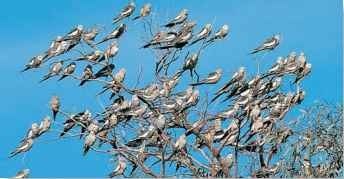
A Separate but equal
Although they may congregate in large flocks, perched cockatiels will not come in contact with each other.
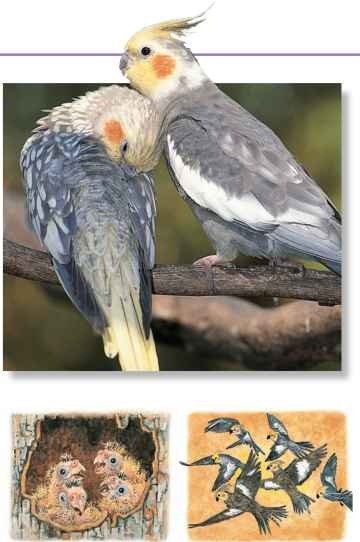
3 Feed me…!
Upon hatching, the chicks almost immediately beg for food and often receive their first meal within two hours of hatching.
4 I’m a big bird now!
Young leave the nest to join the flock after -4—5 weeks but are easily recognizable, with their duller plumage and much smaller crests.
# Travelers in arid regions of Australia have been able to follow the flights of the cockatiel to find water.
# Confined cockatiels have developed almost no homing ability, and they can become hopelessly lost in a house or even in a single room.
CONSERVATION
The cockatiel is not threatened. Because of their occasional raiding of crops, however, there is an open hunting season for cockatiels in Queensland. Elsewhere in Australia they are protected by law year-round. Although they are second only to the parakeet in popularity as a pet, they are not regularly captured from the wild since they are easily bred in captivity.
FOOD & FEEDING
Cockatiels prefer to forage on the ground, searching for small sun-dried seeds from grasses and plants, but they will also perch in trees and shrubs to look for food.The bird husks seeds by rotating them with its tongue while the beak and strong jaws effortlessly crack the seed. The cockatiel also enjoys fruits, berries and the nectar of some flowers. Large flocks may raid, and often completely destroy, crops of ripening sorghum, wheat and sunflowers. Powerful fliers, cockatiels will often take several long flights throughout the day from foraging grounds to water holes. Cockatiels are cautious when coming in to drink and will usually circle an area several times before descending.The bird drinks by immersing its bill into the water, raising its head and allowing the water to flow down the esophagus.
Double duty The cockatiel uses its bill and its tongue to forage.
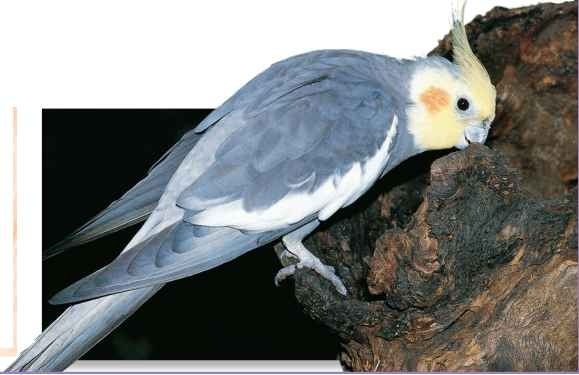
Profile
Cockatiel
The swift and powerful cockatiel reaches incredible flight speeds of up to 44 mph, and is easy to spot with its rosy-orange ear coverts.
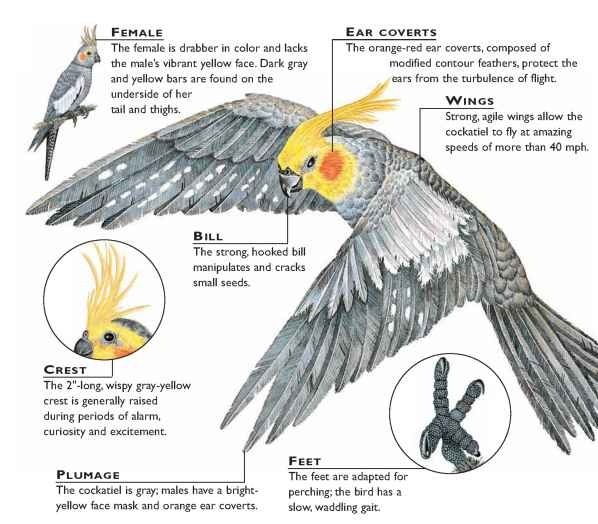
CREATURE COMPARISONS
Major Mitchell’s cockatoo (Cacatua leadbeateri), also known as the pink cockatoo, is mainly white but has a light-pink head, breast and underwing. Measuring up to 15″ long and weighing up to I lb., it is larger than the cockatiel. Its 5″-long, fanlike crest feathers are also longer and more colorful than its relative’s. Major Mitchell’s cockatoo is found among the dry grasslands throughout central and western Australia—a more limited range than the cockatiel. The bird’s rounded wings enable it to fly at a leisurely pace, much slower than the cockatiel, whose narrow wings allow fast flight.
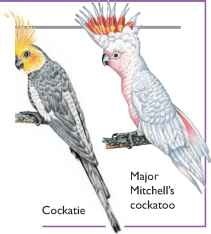
| vital | |
| statistics | |
| Weight | 2.8-3.5 oz. |
| Length | 10-13″ |
| Wingspan | 20″ |
| Sexual f Maturity | 2-3 years |
| Breeding Season | After heavy rains ‘ |
| Number of Eggs | 4-7 |
| Incubation Period | 17-23 days |
| . Fledging j Period | 4-5 weeks |
| Breeding [ Interval | Up to 2 clutches per year |
| Typical 1 iDiet | Seeds, fruits and berries |
| fespan | 15-20 years; up to 38 in captivity |
Related species
• The cockatiel is the only species in the genus | Nymphicus, but joins 20 other species of cockatoo in the family Cacatuidae. The palm cockatoo, Probosciger aterrimus, is the largest cockatoo, weighing over 2 lbs. and measuring almost 2′ in length. The most distinct cockatoo is probably the galah, Eolophus roseicapillus, with its deep-pink face, neck and underparts.
